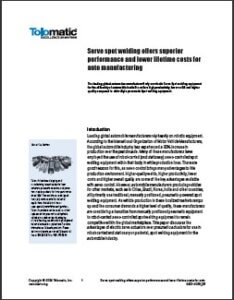Servo spot welding offers superior performance and lower lifetime costs for auto manufacturing
The leading global automotive manufacturers rely on robotic servo spot welding equipment for the assembly of automobile bodies to ensure high productivity, lower costs and higher quality compared to older-style pneumatic spot welding equipment.
Introduction
Leading global automobile manufacturers rely heavily on robotic equipment. According to the International Organization of Motor Vehicle Manufacturers, the global automobile industry has experienced a 30% increase in production over the past decade. Many of these manufacturers have employed the use of robot-carried (and stationary) servo-controlled spot welding equipment within their body in white production lines. There are good reasons for this, as servo control brings many advantages to this production environment. Higher-quality welds, higher productivity, lower costs and higher overall quality are some of the key advantages available with servo control. However, automobile manufacturers producing vehicles for other markets, such as in China, Brazil, Korea, India and other countries, still primarily use traditional, manually positioned, pneumatic-powered spot welding equipment. As vehicle production in these localized markets ramps up and the consumer demands a higher level of quality, these manufacturers are considering a transition from manually positioned pneumatic equipment to robot-carried servo-controlled spot welding equipment to remain competitive within the global marketplace. This paper discusses the advantages of electric servo actuators over pneumatic actuators for use in robot-carried and stationary or pedestal, spot welding equipment for the automobile industry.
Pneumatic actuators on spot welding guns are a mature technology
In vehicle manufacturing facilities around the globe, pneumatic-powered spot welding equipment, both manually positioned as well as robot-carried (and stationary),has been used for many years. This mature technology is well understood and has a low acquisition cost, although a high operating cost.
In general, pneumatic-powered spot welding has some disadvantages compared to electric servo spot welding. Most notable is the consistency of the welds. This is due in part to the pneumatic cylinder having varying clamping force output from one weld to the next. Fluctuating supply air pressure, small leaks in the system and contamination from the environment can all play a part in force output fluctuation. Recognizing this condition, operators may increase pressure to the pneumatic cylinder to overcome consistency issues due to low weld force, but in turn this may aggravate other conditions. These include rapid weld cap wear that requires higher levels of maintenance, and in some cases, burn-through may occur. In addition, metal expulsion from the weld is aggravated due to the high forces—particularly high part contact forces—at the weld point, causing increased contaminants in the environment. These conditions are further complicated with manually positioned equipment that can cause weld caps to be improperly orientated and/or positioned, resulting in poor-quality welds which require redundant positioning or additional welds.
RESULTS OF INCONSISTENT CLAMPING FORCE FROM WELD TO WELD

Air pressure increased to compensate Rapid cap wear and burn through Higher expulsion, misplaced welds, poor
for low weld force quality, and required redundant positioning
Figure 1: Air leaks and pressure fluctuations can result in an unpleasant chain of events.
Better cost control with servos
Operating costs for pneumatic spot welding equipment can be a significant part of an automotive manufacturer’s overall body shop expense. High-efficiency air compressors are not only expensive to purchase, install and maintain, they are also notoriously power hungry, and many times need to run continuously in order to provide an uninterrupted supply of compressed air. In addition, with hundreds of connections and miles of piping and tubing to deliver the compressed air to each spot weld station, leaks are inevitable. This affects efficiencies and further increases operating costs.
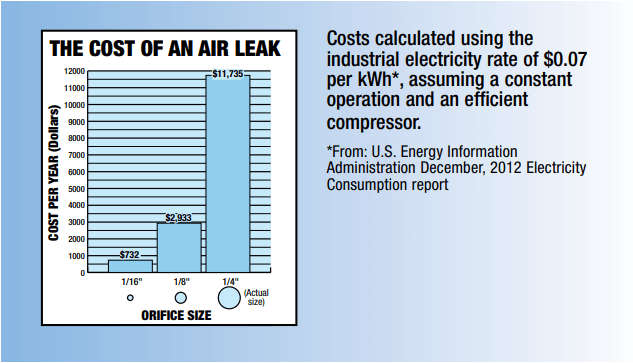
Figure 2: The above chart shows the sometimes hidden costs of pneumatic welding.
There are also pneumatic systems which utilize “servo-pneumatic” devices on spot welding equipment. These systems are programmable for a variety of functions; however, they are more complex as they must contend with servo control of a compressible fluid (air). While servo-pneumatic systems add features such as programmability and added control over conventional pneumatic systems, they are still fundamentally pneumatic and may suffer the same conditions of air leakage and high operating costs.
Electric servo-powered spot welding equipment has numerous advantages over its pneumatic and servo-pneumatic counterparts. Even though the acquisition cost of a servo actuator for use in a spot welding gun is higher—in some cases up to five times higher than the pneumatic counterpart—the lifetime cost is lower. For example, in a production facility with 200 weld guns the annual electric utility cost savings (assuming no air leaks) would be in excess of $90,000 (see ROI calculation on page 7). There can also be savings from less frequent weld cap replacement, as servo actuators employ fully controlled moves with softer impact that result in less cap wear. In addition to less weld cap wear, tip dress frequency is reduced minimizing copper loss on weld cap tips. Replacing one less weld cap per day on each gun in a plant could result in a cost savings of up to $100,000 or more over a 5-year period. The fact is that servo actuators simply last longer, yielding more welds than a pneumatic cylinder, and their flexibility allows them to be easily redeployed in new programs. In resistance spot welding, servo actuators can last up to 10 times longer than a pneumatic cylinder. In addition, there is no need to route an air supply to the robot’s multiple axes, which eliminates maintenance of air lines caused by the robot’s twists and complex moves. The result is increased life and reliability when using a servo system.
Servos offer precision control
There are, however, even greater advantages when servo control is deployed. The most notable advantage is that the movements of a servo-actuator system can be very precisely controlled. This means that the system can be “programmed” to do just about any motion, at any time, with high repeatability, and virtually eliminate redundant or unnecessary moves.
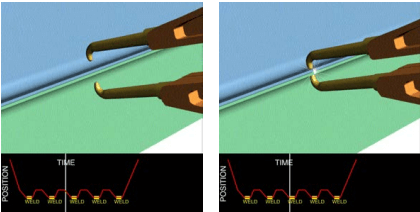
Figure 3: The illustrations above show the small precise moves that are possible with a servo spot welding program. Faster, high quality welds are possible.
For example, a typical weld cycle may begin with the weld gun open or positioned where the weld caps are the farthest apart. Next, the servo is “programmed” to make a rapid or high-speed move to a position very close to the material to be welded. Then, at a controlled rate, the weld caps contact the material to be welded, hold it at a constant force while the weld occurs, then retract to a position near the material and move to the next weld position. This movement is gentler than that of a pneumatic system, resulting in longer weld cap life, more consistent welds and less part distortion. A number of welds are generated before the weld gun returns to a full open position to allow work to begin on a new part, saving positioning time. All moves in a servo system are “programmable” for position, force and velocity, which may be optimized for each part to be welded. This, along with the fact that all of the welds are under the control of the robot controller, generates near-perfect synchronization of all moves and all welds. Additionally, the system monitors electric current to the servo motor. When the weld tips are in position and the squeeze force has been attained (based on system calibration and pressure tables), the system initiates a “ready to weld” signal. This eliminates unnecessary waiting or delays in the process. In addition, complete interpolated motion of all seven axes, including the servo actuator on the RSW gun, allows for optimal weld-gun and weld-process motion with maximum throughput and efficiency. To achieve these benefits, it is necessary to use a feedback device that is compatible with the seven-axis robot controller.
Pneumatic systems, on the other hand, possess limited ability for programming position or velocity, and force is dependent on operating pressure. In reality, pneumatic systems have a tendency to contact the part abruptly with a variable amount of force and then retract to a preset position abruptly before repeating another adjacent weld. This type of behavior has earned pneumatic systems the badge of “bang-bang” technology because of the rather abrupt preset position to preset position moves. Also, because pneumatic systems are going to a preset position, the distance traveled by the pneumatic cylinder is longer than the distance traveled by a servo actuator and requires additional cycle time. Additionally, when using pneumatically operated weld guns, the “weld” signal is not initiated until the robot’s six axes have moved the weld gun into position. At this point, the weld signal is initiated with a “time-based”command rather than a “when-ready-based” command waiting for the weld tips (driven by the pneumatic cylinder) to make part contact. This time-based command is necessary because the physical weld tip (or air cylinder) movement time will vary based on pressure fluctuations in the air supply and concurrent air usage from other adjacent weld guns and pneumatic cylinders.
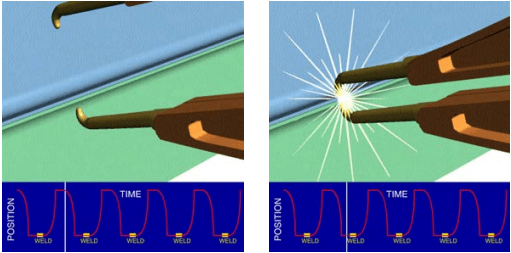
Figure 4: Pneumatic spot welds require a larger fixed open setting resulting in slower welds than servo spot welds and create higher expulsion contaminants.
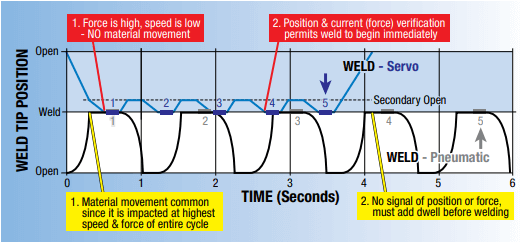
Figure 5: The above chart shows the decrease in weld cycles using a servo “ready-to-weld” signal vs. a pneumatic “time-based” command.
As these charts and illustrations show, servo welding technology can decrease cycle time and increase throughput. In addition, since weld cycle efficiency is optimized, it many times results in less welding gun stations that need to be employed throughout a vehicle production facility creating further cost and maintenance savings.
Programmability increases quality
A servo’s ability to be “programmed” for critical operating characteristics automatically increases quality. The controlled part contact velocity and force being applied provide a more repeatable clamping force during the weld. As a result, metal expulsion goes down, weld cap wear is reduced, tip dress frequently is reduced, burn-through is eliminated and the number of redundant welds required to ensure part integrity goes down. When robot-carried servo spot welding equipment is compared to manually positioned pneumatic spot welding equipment, the benefits are even greater. By eliminating natural human error in positioning the spot welding tool, weld quality and overall part quality take giant leaps forward. Robots have the ability to position the spot welding tool very accurately. Because of this capability, welds may be positioned exactly where needed. Plus, robots are capable of positioning welds that may not be accessible by humans without presenting safety hazards. The fact that servo-controlled spot welding equipment is “programmable” has other notable advantages as well. For example, a servo system is also capable of being reprogrammed. This means that a system may be redeployed or re-purposed for another task. This allows a vehicle manufacturer to not only take advantage of the programmability aspects but also reuse the equipment on multiple vehicle platforms, gaining maximum benefit from both the robot and the servo spot welding equipment. Many times this can be a way to achieve the required ROI for the capital equipment. This can be particularly advantageous in emerging markets where vehicle production volume may be lower and may not fully justify robotic equipment on a single vehicle platform.
Return on investment can be as little as a year and a half
In conclusion, servo weld guns provide higher-quality welds, less maintenance, lower operating costs, increased equipment life and a better ROI than their pneumatic weld gun counterparts in automotive resistance spot welding applications. With all these benefits, the ROI for a robot-carried servo gun in high-volume production facilities has been calculated by some manufacturers to be less than a year and a half.* Vehicle manufacturers who are currently using hand-positioned or robotic pneumatic spot welding should analyze the benefits of servo robotic welders. Often, the increases in manufacturing quality and the inherent competitive advantages are reason enough to justify the investment.
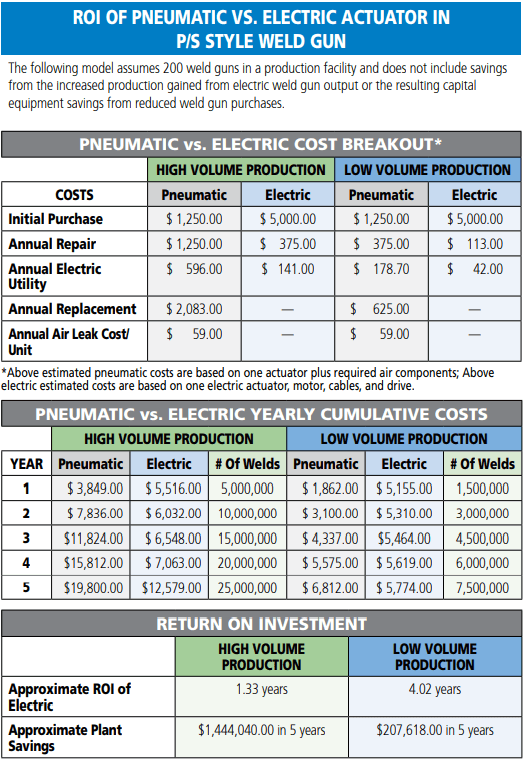
DATA ASSUMPTIONS
- Estimated life of electric actuator (# of welds): 20,000,000
- Estimated life of pneumatic actuator (# of welds): 3,000,000
- Repair life of pneumatic actuator (# of welds): 1,000,000
- Repair life of electric actuator (# of welds): 10,000,000
- Pneumatic maintenance (materials and labor): $250.00
- Electric maintenance (materials and labor): $750.00
- High volume production (welds/year): 5,000,000 ~ 1000 vehicles * 15 welds per vehicle per gun * 350 production days
- Low volume production (welds/year): 1,500,000 ~300 vehicles * 15 welds per vehicle per gun * 350 production days
- Efficiency of pneumatic system: 17.5%
- Efficiency of electric system: 74%
- Cost of electricity (kW/hr.): $0.07
- 1/4-inch hole air leak/ annual cost: $11,735.00 (Assuming air leak from infrastructure needed for 200 units in factory for P/S style application is approximately accumulative to 1/4-inch
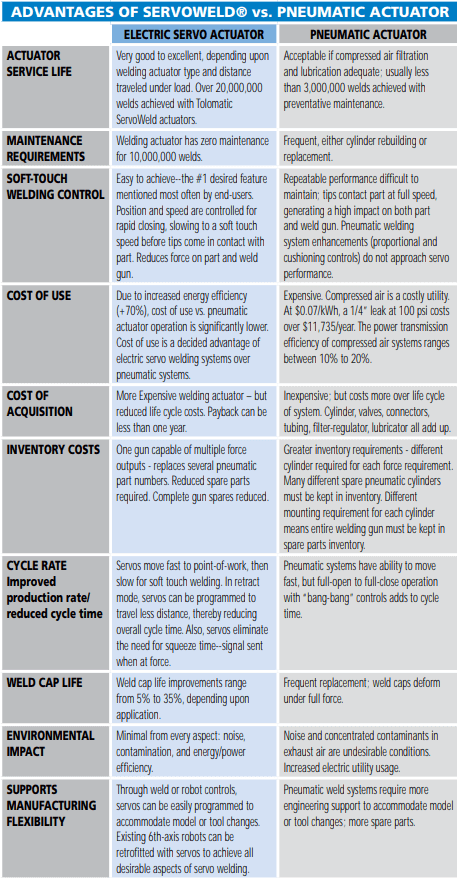
For more information on ServoWeld® actuators, visit our website at: www.tolomatic.com and download our brochure.

 Ask an Engineer
Ask an Engineer